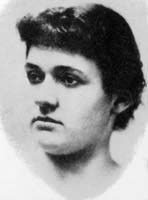Mary Lawrence (sculptor) facts for kids
Mary Lawrence (Tonetti) (1868–1945) was an American sculptor. A sculptor is an artist who creates figures and statues from materials like clay or stone. Mary Lawrence is best known for designing a large statue of Christopher Columbus for the World's Columbian Exposition in 1893.
Early Life and Training
Mary Lawrence was born in New York City in 1868. She came from an important family with a long history in New York. Her ancestors included John Lawrence, who was the mayor of New York City multiple times in the late 1600s. Another ancestor was Captain James Lawrence, a hero from the War of 1812.
Mary Lawrence studied art at the Art Students League of New York. There, she was a student of the famous sculptor Augustus Saint-Gaudens. He was a very influential artist and helped guide her early career.
Creating the Columbus Statue
In 1893, Mary Lawrence received a big opportunity. Her former teacher, Augustus Saint-Gaudens, suggested her for an important project. She was chosen to create a huge statue of Christopher Columbus. This statue was for the World's Columbian Exposition in Chicago.
The Exposition was a huge world's fair. Many buildings and sculptures there were made from a temporary material called staff. This material was like plaster and was not meant to last forever. Because of this, Mary Lawrence's Columbus statue no longer exists today.
Some people thought that Saint-Gaudens or his brother had actually made the statue. However, Saint-Gaudens himself said that Mary Lawrence "modeled and executed it." He gave her full credit for the statue's lively and grand style.
There was a small disagreement about where the Columbus statue should be placed. At first, it was moved to a less important spot. But Charles Follen McKim, a well-known architect, helped get the statue moved back to its original, prominent location.
Later Career and Life
After the World's Columbian Exposition, Mary Lawrence continued to work with Saint-Gaudens. She helped him create the General John A. Logan monument for Grant Park in Chicago.
Later, she moved to Paris, France, to continue her art studies. She attended the Académie Julian, a famous art school. In Paris, she met Francois ML Tonetti, who was also a sculptor. They got married in New York City in 1900.
Mary Lawrence Tonetti continued to create art after her marriage. She worked with her husband on several projects. For example, they created two fountains for the Pan-American Exposition in Buffalo, New York, in 1901. In 1907, they also contributed two statues, named Venice and Spain, to the US Customs House in New York City. These statues were placed on the building's cornice, which is a decorative ledge.
Mary Lawrence Tonetti was also involved in supporting the arts. She helped start the Cosmopolitan Club in New York. She also helped create an artists' colony at her family's ancestral home in Sneden's Landing, New York. This area is now known as Palisades, New York.



